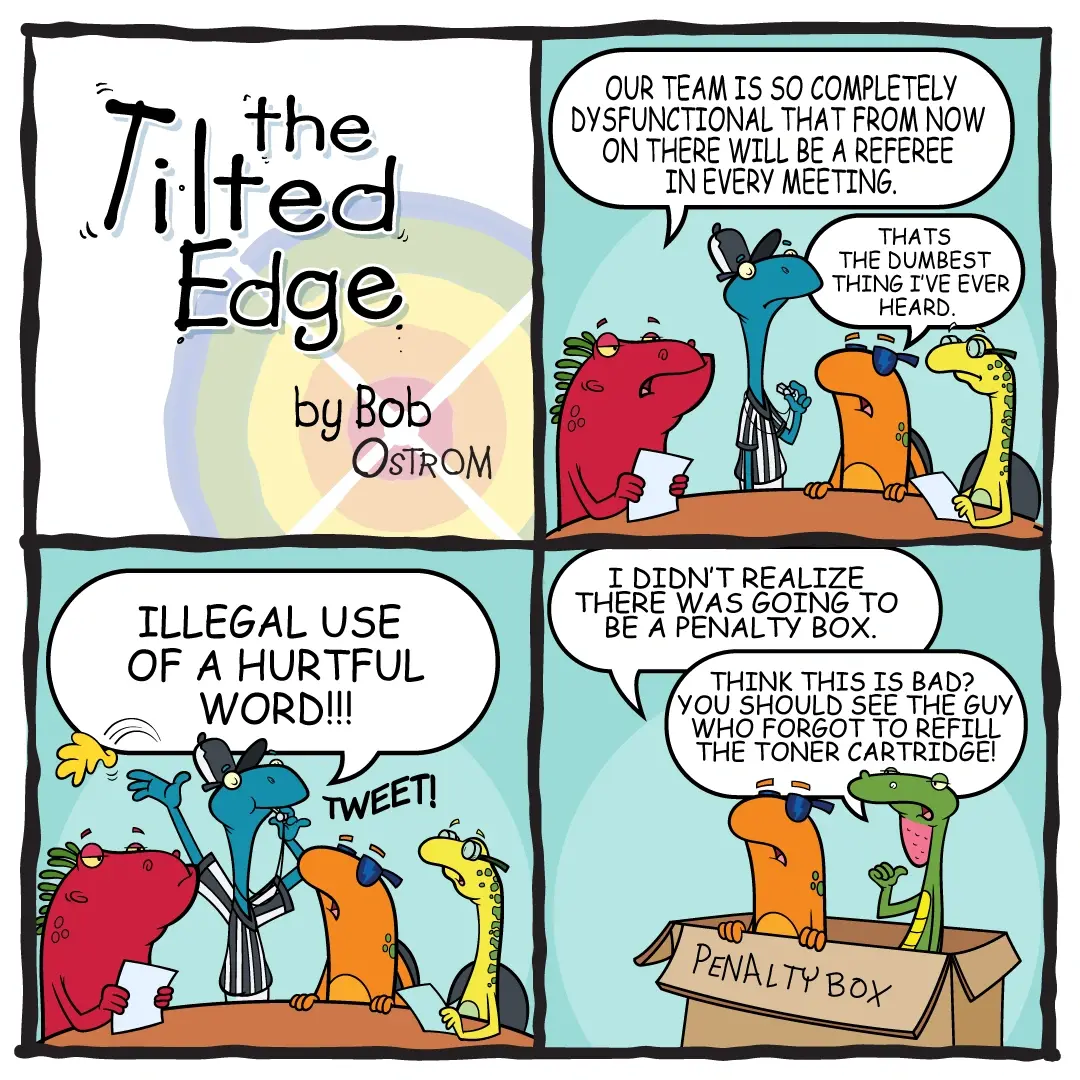How to Mend Dysfunctional Teams: A Definitive Guide


Dysfunctional Teams: 12 Points of Dysfunction
Hitting the bullseye in archery is difficult, and it becomes needlessly challenging if the bow is broken or poorly constructed. Similarly, accomplishing tasks at work as a team can be tough, and it becomes unnecessary so if team dysfunction is present. Yet broken teams are not necessarily as easy to diagnose as a broken bow. If the team is fractured in some way, how do we address the problem?
5 Dysfunctions of a Team
Researchers have published findings related to dysfunctional teams for years, so thankfully, our rhetorical question can be answered. A great place to start might be to delineate and summarize various forms dysfunctions of a team can take.

Patrick Lencioni, one authority on team dysfunction, posits that there are five dysfunctions of a team:
- Absence of Trust
- Fear of Conflict
- Lack of Commitment
- Avoidance of Accountability
- Inattention to Results
He also explains that no team is immune to dysfunction, and healing a dysfunctional team must begin with correctly classifying its form(s) (and severity).
Patrick Lencioni states that a lack of trust might be present if team members resist admitting fault and/or do not feel at ease with each other. As we mentioned in Tilt’s Team Performance blog, small amounts of conflict in teams can be beneficial. But constructive conflict is much harder to achieve without trust. If a team lacks constructive conflict, ambiguity will thrive because its members are reluctant to assume particular tasks. The people most hurt by such ambiguity tend to be the highest-quality employees.
Since it’s important for workgroup members to voice concern when they feel that others are behaving counterproductively, tasks need to be delegated explicitly. When accountability is absent, team members behave more individualistically. The Lencioni Model (also known as the Lencioni Pyramid) posits that the five dysfunctions of a team build on each other so that the first has to occur before the second and the second has to occur prior to the third, etc.
These five dysfunctions of a team are helpful partly due to their simplicity. Any of us can remember a time when we worked as part of a team that lacked trust, was fraught with conflict or was composed of individuals who did not align with the group vision. Since teamwork often entails splitting duties according to strengths and weaknesses, it is not hard to imagine why a lack of trust can hamper productivity. Specifically, if we believe that someone on our team will not put their full effort into an assignment, we might get distracted from our personal duties by determining what we will do when that other teammate fails to pull their weight. Social loafing can aggravate team dysfunctions and then, subsequently, harm satisfaction.
Diagnosis of Team Dysfunction
Dysfunction can go undetected until it has advanced so far that outside help is fruitless. In academic settings, sometimes very intelligent people perform well in terms of learning course material in a given semester, but they resist complying with assigned team members and therefore fail to improve their team mentality. This is relevant because it is important to understand that workgroups made up of very smart and/or driven people are not inherently immune to team dysfunction concerns.
Team dysfunctions can happen regardless of whether mentorship exists, and causes include low engagement, high conflict, and management issues. Therefore, methods for predicting dysfunctional teams include assessing engagement, conflict, and management quality. Returning to Patrick Lencioni: he created a diagnostic tool for assessing the degree of team dysfunction currently in existence and called it the Lencioni Team Assessment. This assessment requires the user to answer thirty-eight questions where the resulting scores reveal which of the five levels of the Lencioni Model (described earlier) need to be addressed within a given team.
If, for example, scores for Conflict are wanting, workgroups may benefit from increasing their comfort level for discussing difficult subjects. Targeted suggestions such as these yield benefits because they help workgroups narrow down the list of possible seeds from which team dysfunctions sprout. Teams who complete the Lencioni Team Assessment—and subsequently discover elements of Team Dysfunction—can benefit from continuing to read below where we present some coping methods pulled from the team dysfunction literature followed by ways in which Tilt can lend relevant aid.
Mending Dysfunctional Teams
Resolving team dysfunction is not a skill that can be sufficiently developed in the absence of practice and real-world team experiences. Just as we hire experts to teach us how to play tennis or service a racing bike, it is important to consult experts on a dysfunctional group if we determine that dysfunction is present in a team. When dysfunction at the team level exists, we can expect frustration and dissatisfaction. Since it is usually the case that we want to eliminate frustration and dissatisfaction at work, it is important that we focus our efforts on eliminating team dysfunctions quickly.
Despite the fact that mentorships do not inherently make teams immune to dysfunction, one experiment revealed that mentorship significantly reduced the degree of team dysfunction present. The rationale was that mentorship sessions provided teammates the opportunity to voice concerns, to know they weren’t alone in their trials, and allowed mentors to diffuse situations before they got too out of hand. Mentors were specifically assigned the task of this situation diffusion.
An additional method theorized to help repair dysfunctional teams is the concept of triple-objective mentoring, where teammates are advised about team best practices and to address problems as quickly as possible without requiring the involvement of any third parties. The results of one intervention were that triple-objective mentoring eliminated academic failure due to social loafing or discord. Yet another benefit of having formal mentor meetings is the opportunity to come to an agreement about how to enhance communication down the road.
How Tilt 365 Can Help
If we succeed at avoiding a negative outcome, we are inherently freed from having to fix it. The strategy for avoiding the 5 Dysfunctions of a Team, according to Patrick Lencioni, involves making it easy for team members to raise concerns (even when concerns are more sensitive in nature), mitigating ambiguity, being professional and mature while digesting issues, and approaching work with a collective mindset. We feel that one avenue for enabling comfortable discussion of concerns and mitigating ambiguity is helping teammates understand each others’ personalities, preferences, and working styles.
This is just a single area in which Tilt365’s suite of individual and team assessments can provide aid. Our assessments allow the user to learn about their natural tendencies, to learn about the natural tendencies of others, and to uncover personal blind spots (all of which help to reduce team dysfunction). Tilt’s extensive directory of trained coaches can also serve as mentors for your team member, leader, or business in an effort to prevent dysfunction and to resolve it when it occurs.
Closing
Most companies are composed of teams with leaders, and those companies benefit more and more as the teams perform better and better. One method of enabling better team performance is preventing dysfunction from materializing. And if new team dysfunction materializes, it is crucial to alleviate the change as soon as possible. While a blog cannot contain a comprehensive summary of dysfunctional group best practices, it can highlight the most important and useful information.
At Tilt 365, we genuinely care about the companies we serve and the people that make them up. One way we enact this care is by publishing content that hopefully sparks meaningful insights for the reader to create change. Because we have invested so much time and energy into making our assessments as sound and as useful as possible, we believe that they can yield great gains for our users. Alleviating and preventing dysfunction in workgroups is just one realm where our assessments will provide aid. How will Tilt 365 help you and your team remedy any existing dysfunction? If you enjoyed this blog, consider clicking the share icon below, and don't forget to subscribe to our blogs for more things, such as our free downloadable guides on mindsets and happiness.




